Premature Burial: The Horror of Being Buried Alive
by Doug MacGowan, March 2016 – Updated June 2019
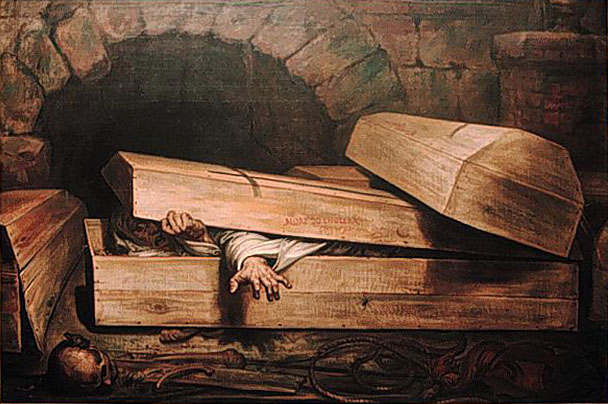
Premature Burial and Three Real-Life Cases
Imagine for just a moment waking up in a coffin six feet under the ground in complete silent darkness, gasping for air with no way for anyone to hear your labored screams. Premature burial, also known as being buried alive, is one of the scariest things that can ever be imagined.
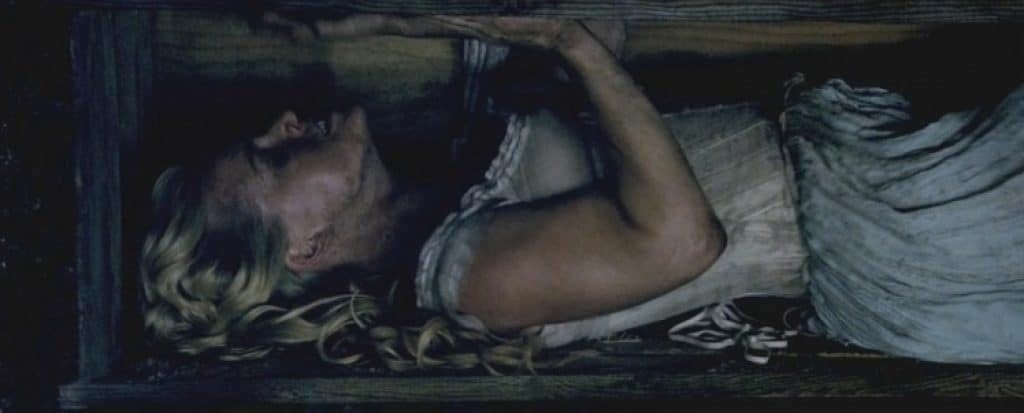
A woman buried alive in a coffin. Image: “The Raven.” video still
The fear of being buried alive is called taphophobia. Although few, if any, modern people like the idea of being interred while alive, society in the 19th century turned the fear into a large and popular wave of terror.
There may have been some reason for that fear. Before embalming became standard practice, there were unfortunate true stories of people who had been mistakenly thought of as dead. The fact that they had been, perhaps, in a coma and were buried alive was discovered only later after the corpse was exhumed for whatever reason.
Signs of Premature Burial
Probably the first noted episode was Scottish philosopher John Duns Scotus (1266-1308). At some point after his death, his tomb was reopened and they found the corpse half outside the casket and his hands and fingers bloody from trying to escape from his early eternal rest.
The bloody fingers were a common sign of premature burial. Often when coffins were opened after someone’s “death,” the body would be found in a twisted position with scratches all over the interior and fingernails completely bitten or scratched off in an unsuccessful attempt to escape the grave.
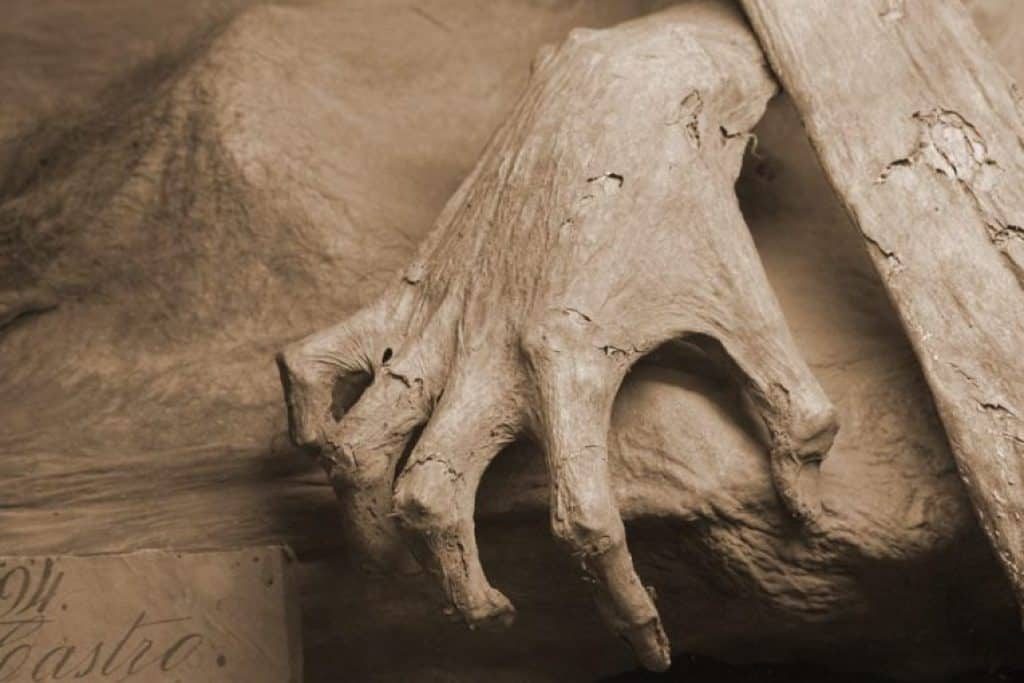
Hands often bore the signs of premature burial. Wikimedia Commons, Tomascastelazo
Premature Burial as a Form of Execution
Not all live burials were accidental, however. Live burials are known to have been a method of execution in China and the Khmer Rouge.
You May Also Like:
Creepy Graves and the Stories Behind Them.
And a piece of folklore states that in the 6th century a monk who is now known as St. Oran was voluntarily buried alive as a human sacrifice to ensure the successful construction of a church on the Island of Iona off the Scottish coast. The burial went through, and after some time, the coffin was brought back up and they found Oran barely alive. He was, however, able to report that the afterlife had no hell or heaven. This distressing news to a Christian community caused Oran to be quickly reburied for good.
Safety Coffins for Taphophobia
As with any other widespread fear, certain opportunists took advantage of people’s fear and turned it into a commodity to fill their coffers. The concept of a “safety coffin” was developed that would assuage the fear of live burial. There were a variety of expensive designs that hit the marketplace.
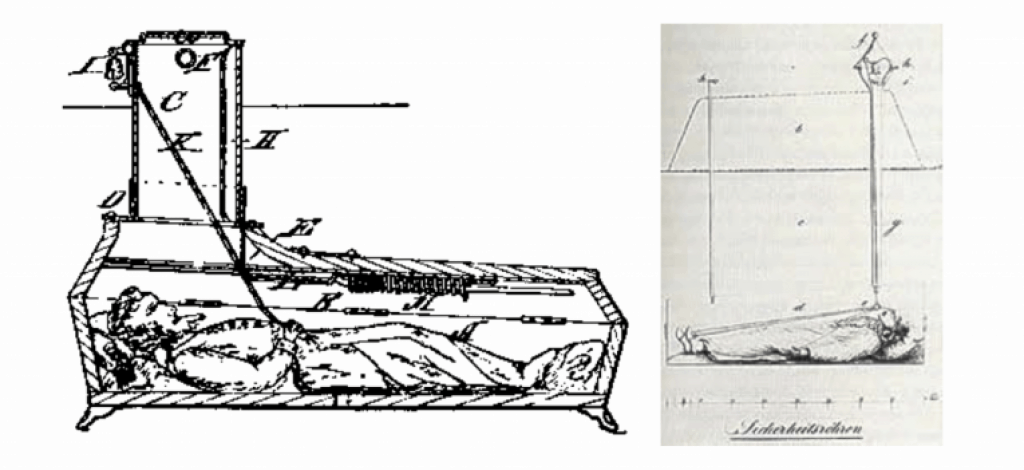
Two different early designs for safety coffins with bells. Public domain.
In 1791, a minister was buried in a coffin with a glass pane in it that would allow a cemetery watchman to check and see that the minister was, in fact, dead. Another design consisted of a coffin with air pipes and keys to the coffin and tomb in case the live occupant needed to get out of his burial tomb. A late 18th-century coffin consisted of a string that would ring a bell or wave a flag above ground if the buried person was not actually dead.
These escape coffins were not just for the Victorians. In the 1990s, a patent was granted to construct a coffin featuring alarms and flashlights and medical equipment to keep a person alive while laborers dug up the body. As far as we know, nobody buried alive was ever brought back to the realm of the living from the use of a safety coffin.
Fiction Reflects Obsession
The topic of premature burial is not limited to the realm of the scientific and commercial. As a result of the widespread fear of live burial during the 1800s, The Premature Burial by Edgar Allan Poe emerged in 1844. His short story was about a man who suffered profound taphophobia as a result of his cataleptic condition. He worried that people would mistake him as dead during one of his episodes and bury him alive.
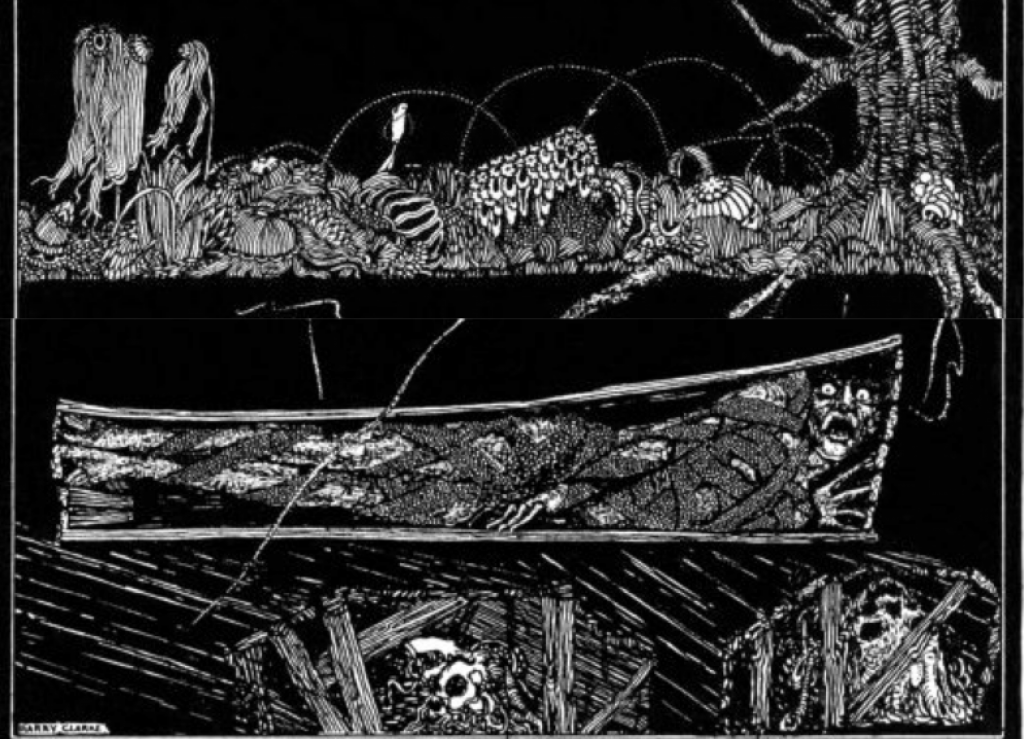
Edgar Allan Poe, The Premature Burial. Public domain, modified.
Although The Premature Burial had a profound impact on the taphophobic society of the time, there have been many movies featuring premature deaths. Some of those movies reflected Edgar Allan Poe’s multiple stories on the subject. Even today, reading his works can still send a shiver up one’s spine, with his detailed accounts of unfortunate people who had tried desperately to dig, scratch, or bite their way out of their coffins.
Three Historical Cases of People Being Buried Alive
For the following three people, a safety coffin could have been useful. Here are three real-life premature burials of individuals who woke up inside their graves.
Angelo Hays – France (1937)
Known through town for his love of riding his motorcycle, Angelo Hays was riding one day and was thrown from his bike after hitting a curb and hit a brick wall headfirst. At the age of 19, he was pronounced dead from massive head trauma. His face was so disfigured that his parents were not allowed to see him before being buried. The doctor declared him legally dead because he could find no pulse, and thus, Angelo was buried.
Because of an insurance policy that Angelo’s father had taken out on him a few months earlier, the insurance company had some suspicions and requested the body be exhumed two days later. Once the body was exhumed and unwrapped from the burial clothes, they found that Angelo’s body was still warm and there was a faint heartbeat. After being revived and making a full recovery, Angelo became a celebrity in his native France.
Virginia MacDonald – New York City (1851)
After a prolonged illness, Virginia MacDonald, who was living with her father, finally succumbed to her illness and passed away. She was buried in Greenwood Cemetery in Brooklyn. Her mother, however, insisted that Virginia was not dead. No matter how relatives tried to console the mother and convince her Virginia was dead, she would not believe them.
It finally got to the point that the family agreed to have the body exhumed to convince the mother that her daughter was indeed dead. When the body was finally exhumed, it was discovered the body was lying on its side. The hands had been bitten badly and had all indications that Virginia MacDonald was indeed alive when she was buried. Her daughter’s premature burial would continue haunting her mother.
Mary Norah Best – Calcutta (17th Century)
Just 17 years old, Mary Norah Best, who had been adopted by Mrs. Moore Chew, succumbed to the outbreak of cholera. Because of the heat of the region and the spread of disease, her family decided to bury her quickly. They signed the death certificate. Then they put her body into the ground at the old French cemetery. She was in a pine box with the lid of the coffin nailed shut. There were always questions surrounding the circumstances of her death. But no matter, the body was left to rest in peace.
Ten years later, the family crypt was unsealed to allow for the brother’s body to be interred in the crypt. When the family entered the crypt to place the second coffin, they found the lid of Mary’s coffin broken open. Also, there was evidence that she had tried to climb out. Her skeleton lay half in and half out of the coffin. It was later believed that the doctor who had signed the death certificate had actually poisoned the daughter. Then later, he attempted to kill the mother.
Hope For the Dead to Remain So
For each of these three examples of premature burial, there are numerous others on record of people who had been found dead in their graves after having tried painfully to escape. Imaginably, there were even more poor souls who had awoken in their coffins never to be discovered. As difficult as it is to fathom, there are many recent cases of people waking up sometime after having been pronounced dead. One man woke up just as he was about to be embalmed!
Nowadays, a living person would not stand a chance of rescue if they were not quite dead, considering the standard process of embalming a body after death. The best we can do is hope that the horror of premature death never becomes a reality for you or any loved ones and that the finality of death really is final.
Co-authored by Jim H.
References:
Daily Mail
OdditiesBizarre.com
Listverse
Updated 10/17/16